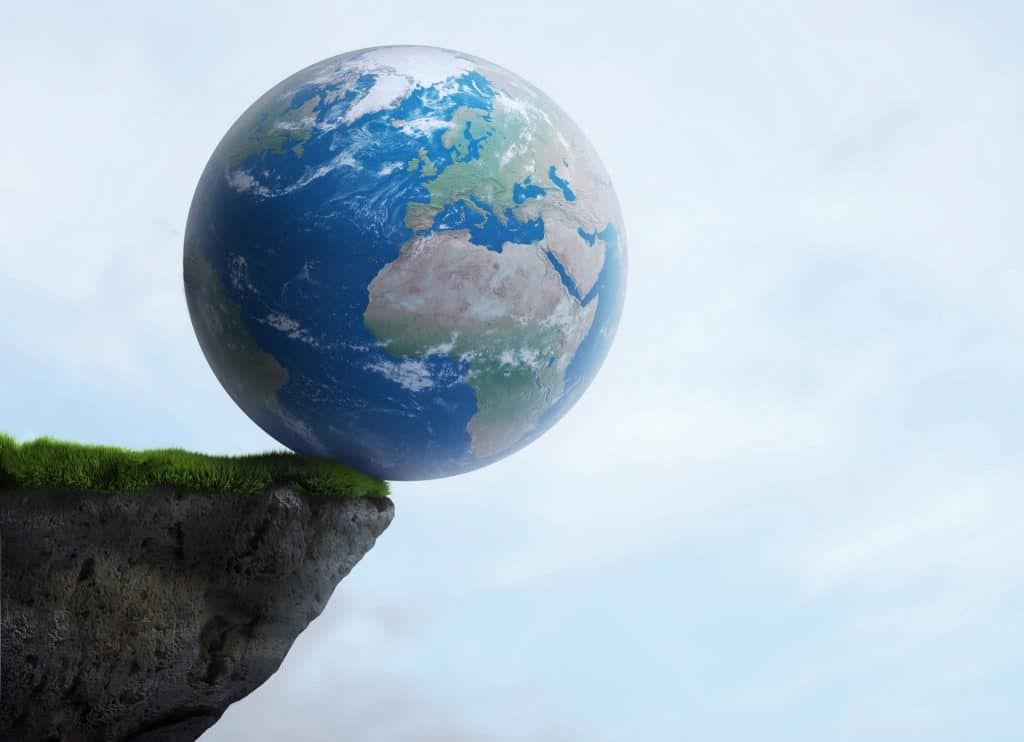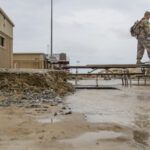COVID-19 and the Doomsday Clock: Observations on managing global risk
By Science and Security Board | April 15, 2020

On January 23, 2020, the Science and Security Board of the Bulletin of the Atomic Scientists moved the hands of the Doomsday Clock forward to 100 seconds to midnight. We board members warned then that the world’s institutional and political capacity for reducing the possibility of civilization-scale catastrophe had been diminished, and the need for emergency action was urgent. In our statement, we explained that because of the worldwide governmental trend toward dysfunction in dealing with global threats, we felt compelled to set the Doomsday Clock closer than it had ever been to apocalypse.
Three months later, the transformation of the novel coronavirus outbreak into a global pandemic is demonstrating the importance of domestic and international governance, not only in the mitigation of and response to global challenges such as a pandemic, but also in their prevention. In short, as the world is now seeing, governmental dysfunction can cost lives. Competent, timely actions to prevent and mitigate future global crises—whether they involve biological, nuclear, climatic, or other major threats—will depend on the world’s ability to address three fundamental governance concerns.
The first involves the need to repair a worldwide erosion of infrastructure for managing crises. We noted in January that leaders had undermined cooperative, science- and law-based approaches to managing the most urgent threats to humanity, helping to create a situation that will, if unaddressed, “lead to catastrophe, sooner rather than later.” This dysfunction is most evident in the United States, where active political antagonism toward science and government-sanctioned disdain for expert opinion have led to the dismantling of programs crucial to disaster prevention (such as the US Agency for International Development program for warning of pandemics) and mitigation. The COVID-19 pandemic shows the dangers of dysfunction at many levels of government, exacerbated by failures to provide adequate authorities and resources necessary for a robust response.
Our second concern relates to immediately arresting and rapidly reversing the decreased commitment among nations to international cooperation. In our Doomsday Clock statement, we highlighted a disturbing trend, in which influential leaders had denigrated and discarded the most effective methods for addressing complex threats—international agreements with strong verification regimes—in favor of their own narrow interests and domestic political gain. Over the years, there has been no dearth of calls for increased international cooperation on biothreats—just a startling lack of response to those warnings. Imagine for a moment if a September 2019 report by the World Health Organization’s Global Preparedness Monitoring Board about the lack of preparedness for a lethal respiratory virus had been heeded:
A rapidly spreading pandemic due to a lethal respiratory pathogen (whether naturally emergent or accidentally or deliberately released) poses additional preparedness requirements. Donors and multilateral institutions must ensure adequate investment in developing innovative vaccines and therapeutics, surge manufacturing capacity, broad-spectrum antivirals and appropriate non-pharmaceutical interventions.
Our third concern centers on addressing the manipulation and distortion of information that has led to a deterioration of governmental and civic response to global threats. A chaotic and corrupted global information environment now leads, far too often, to the devaluation of facts and rational discourse. Indeed, the World Health Organization describes the information environment surrounding the COVID-19 pandemic as an infodemic, making it hard for people to find trustworthy sources and reliable guidance.
This pandemic highlights how much is to be gained by avoiding the cost—in lives and treasure—of misinformation, especially when that misinformation is purveyed by government officials, as has occurred in many countries during the pandemic.
Our observations so far. COVID-19 brings into sharp relief how catastrophe feeds on dysfunction in national and international governance. The pandemic has illustrated, all too well, the diminishment of crisis management infrastructure, the decreased commitment to international cooperation, and the mis- and disinformation problems that we warned of in January. But the current crisis has also provided clues as to how governments around the world might improve their performance, not only during this and future pandemics, but also in regard to the global, existential threats presented by nuclear weapons and climate change.
Many thorough after-action assessments will be conducted once the coronavirus pandemic wanes. Already, however, the world’s response to COVID-19 has shown some ways in which the management of global threats can and must be improved:
Proactive leadership beats off-the-cuff responses. The potential for a pandemic was well-known long before the COVID-19 outbreak began in China, and yet governments around the world failed to invest sufficiently in prevention, preparedness, and surveillance. The time to act on the lessons of Crimson Contagion—last year’s US government pandemic exercise that eerily predicted many of the things we are seeing today—was December 2019, not March 2020.
For climate risks, timeliness is also key. Actions taken now to transition away from carbon-intensive energy can avert the most catastrophic consequences of climate change. Delay, on the other hand, will make the world choose between evils: hasty and costly energy transitions or enormous, unmanageable climate impacts, like the disruption of tropical monsoons that sustain food production for billions of people.
In the case of nuclear weapons, proactive leadership would involve the United States, Russia, and China engaging in serious strategic stability and arms control talks, to head off a new arms race that no country will be able to afford in the post-COVID-19 environment. Better to invest in cooperation now rather than competition that leads to disaster later.
In a crisis, even the prosaic can be profoundly important. Until this pandemic, only a few experts imagined that insufficient numbers of masks, gowns, and throat swabs could present such an enormous threat to humanity. In the case of nuclear weapons, common everyday events have triggered false nuclear alerts—solar storms, sunlight glinting off a cloud, the rising moon, and failures of telephone switches, computer chips, and human beings. Reducing the greenhouse gas emissions that cause climate change may depend in part on boring, well-known solutions—energy savings from more efficient vehicles and from buildings that are painted white to reduce cooling needs.
Attending to these smaller details, of course, requires implementing a larger strategy that builds awareness of the benefits—both to the public welfare and to the public’s wallet—of simple measures that reduce global risk.
Thinking the unthinkable is not enough. The World Health Organization called for countries to “commit and invest” in global health preparedness. In the midst of the pandemic, the United States is allocating more than $2 trillion to fight a disease with a mortality rate of roughly two percent, an expenditure that now seems reasonable and necessary. Before COVID-19, US officials thought about the possibility of an unthinkable pandemic, but requested only about half a billion dollars in each of the last five years for global health security.
Today, massive lifestyle adjustments are necessary to limit the risk of infection; those adjustments seemed unthinkable just a month or two ago. The analogy to the climate situation is inexact, but instructive, nonetheless: Many people consider major and permanent changes in energy systems and consumption patterns to be unthinkable responses to a distant and abstract climate threat. But citizens around the world may find much more extreme sacrifices forced upon them—sacrifices produced by huge climate disruptions that humanity simply cannot control—should the world fail to take the necessary steps now to rein in greenhouse gas emissions.
Of course, nuclear strategists have been “thinking about the unthinkable” at least since Herman Kahn published his book of the same name in 1962. But if the world is to survive the nuclear era, policy makers must somehow now think their way through the difficult problem of building a secure world that contains no nuclear weapons.
There is a risk in overestimating humankind’s ability to control the escalation of a crisis. The pandemic, so far, has shown the difficulty and costs of making important decisions in the face of imperfect and competing sources of information. In the United States, President Trump downplayed the seriousness of the pandemic, seeking justification and support from unreliable and scientifically uninformed sources, inside and outside the government. In China, local officials suppressed information about the coronavirus outbreak for fear of angering the central government, thus delaying an effective response and increasing casualties. In these cases and many others, downplaying the risks of an escalation of the crisis has actually increased them.
A nuclear crisis would unfold far more rapidly than any pandemic, with more uncertainty and wider devastation. Much of the infrastructure we can rely on today (communications, logistics, transportation) could be wiped out in a nuclear exchange, complicating decision making. Acknowledging that nuclear war in any form would be unpredictable and uncontrollable is the first step toward seeking measures to eliminate the risk of such wars ever starting.
The climate crisis is unfolding much more slowly, but overestimating our ability to manage it also entails significant risks. It’s not clear whether we will be able to control the disruption that will arise, if the climate system is pushed too far beyond the fairly stable state that has reigned over the past several millennia. The potential for irreversible and uncontrollable changes is significant. Even before the pandemic struck, urgent action was required to reduce these risks. The pandemic suggests that we may need to rethink our confidence in our ability to control escalation once a climate crisis begins in earnest—and plan accordingly.
Possible silver linings: better international cooperation, renewed respect for science. There is the possibility that the pandemic will give national governments around the world an opportunity to see and act on the genuine need for better international cooperation on the management of all global threats. At the very least, the spread of the virus reminds us of the interdependence of sovereign states and the very real human desire for connection. More important, many countries are experiencing the pain and dislocation of responding to a borderless and apolitical enemy. Such a pandemic deserves a global, cooperative response, not the pursuit of narrow interests and domestic political gains. The pandemic has also demonstrated the essential role of science and scientists in identifying and dealing with grave threats to humanity. Ensuring that science-based decision making continues will make our world safer.
We hope the world will emerge from this pandemic better prepared for the next, but there is another opportunity as well, which is to apply lessons learned in this crisis to other global existential challenges. Nuclear weapons and climate change affect human, animal, and plant populations worldwide, with long-lasting effects. Mitigating climate change requires recognizing it as an emergency and accepting that changes in lifestyle and the economy are worth the cost if they save the planet. Maintaining security while also reducing nuclear risks is a genuine challenge—but that effort is far less difficult and costly than the aftermath of nuclear war.
A sustainable future for the next generation will require decisive and proactive leadership, imagination and foresight in preparing for potential crises according to systematic scientific analyses, a dose of humility about our ability to address unexpected developments, and ample courage to make tough choices. That future will begin to arrive only when governments around the world recognize that none of them can achieve it without help from the others.
Together, we make the world safer.
The Bulletin elevates expert voices above the noise. But as an independent nonprofit organization, our operations depend on the support of readers like you. Help us continue to deliver quality journalism that holds leaders accountable. Your support of our work at any level is important. In return, we promise our coverage will be understandable, influential, vigilant, solution-oriented, and fair-minded. Together we can make a difference.
Keywords: COVID-19, Coronavirus, governance, pandemic, risk management
Topics: Biosecurity, Climate Change, Disruptive Technologies, Doomsday Clock, Nuclear Risk















